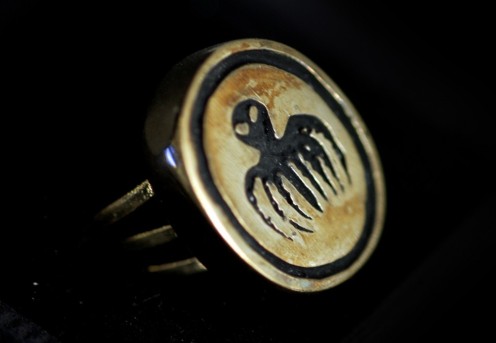The political and apolitical villains in the early Bond universe
The novels

Ian Fleming’s creation, the famous James Bond 007, was born during the Cold War in the early 1950s. The novels, starting with Casino Royale (1953), make it very clear that the predominant ‘enemy’ in the eyes of the British Secret Service are the communist forces working around the world, with of course the Soviet Union leading the charge. Readers soon learn in the initial novel that the principal communist adversary Bond himself will face throughout his adventures is a branch of the Soviet spy hierarchy named SMERSH, an abbreviation for a Russian term meaning ‘death to spies’. Their goal? To eliminate whatever traitors, and potential traitors, that attempt to abandon their side and aid the West. In other instances, as is the precisely the case in Casino Royale, they are sent to execute agents that fail to advance the communist cause. In this case, the fearful SMERSH is obligated to be rid of Le Chiffre after the latter uses a significant amount of funds to jump start some brothels in France. Fate would have it that the French government passes laws which hinder the man’s chances at earning any profit. In fact, as a result of the new legislation, this business venture fails spectacularly. In the early novels, Bond is therefore not only a champion symbol of Great Britain, but one for the West in general. He is, as so many commentators have already written, a ‘product of the Cold War’. By the end of Casino Royale, when 007 learns of Vesper’s betrayal and the reasons behind, the former vows to attack SMERSH at every opportunity. Not only are the communists the enemy from an ideological standpoint, but a special branch of their espionage apparatus has made the war personal. Although the name of Vesper Lynd is never mentioned again until, ironically enough, the novel On Her Majesty’s Secret Service, Bond continuously relishes each opportunity to hit SMERSH where it hurts. This solidifies the appreciation the reader has for Bond’s quests since the enemy is a known evil taken from the real world geopolitical context of the 1950s. The sequel, Live and Let Die (1954), continues this trend in an even more particular fashion, with Fleming creating an enemy who is not only a SMERSH agent operating in the United States and in Jamaica, but also a black man (Mr. Big).
With the third novel, Moonraker, the background of the enemy is slightly altered, but one that is nonetheless easily identifiable and one that readers, whether back in the 1950s or today in 2009, have no trouble hating. Hugo Drax, the multi billionaire scientist with a mysterious past (he returned from WWII with amnesia supposedly) living some miles outside of London, has called on help to shed light on a murder that has taken place in his compound where his crack team of engineers and scientists are working on the creation of a nuclear missile. While I won’t get into the details as to why an employee of the foreign intelligence agency is working on home soil, the point is that Bond’s investigations into the case leads him to the discovery that Drax is in fact a former Nazi (an still a true Nazi at heart), who has dedicated his efforts to destroy London with the same nuclear rocket he is currently building. The launch to be hosted in the coming days is being sold as a publicity stunt that will install fear into the hearts of enemies of Great Britain and its Western allies. All this is an elaborate mission for a spectacular and bloodthirsty lust for revenge on the British for their victory during the last war. Moonraker therefore does not directly feature the communist forces such as SMERSH (although the nuclear warhead attached to the Moonraker is Soviet based, so there is communist support on the side of the antagonist), the villains are well represented by a familiar if somewhat nebulous face: Nazism. Even though Drax is not any sort of high commander within the Nazi organization, he nonetheless represents a force of pure evil recognized and hated the world over. The British themselves fought against the Nazis forces during the Second World War. Of course, Fleming’s juicy descriptions of Drax’s physical appearance and behavioural habits are sufficient for a certain amount of dislike for the character to germinate in the reader’s mind, but the revelation of his affiliation to the Nazi ideology is the icing on the cake, the ribbon hugging the pretty gift wrap: ‘Oh, he isn’t just odd and curiously unpleasant…he’s a Nazi!’. Again, we witness Fleming make use of a well known (and detested) force for the role of the antagonists in a novel. It’s not as though Bond is being sent to hunt down former allies and corrupt agents within the British Secret Service itself. The familiar ‘other’ is always the enemy.
The Films

The philosophy adopted by the producers for the first few films differs somewhat. While Bond is still a beacon for Western, and more specifically British values and interests, the enemies he engages are less political in nature than in the early novels. They are apolitical in fact. Consider the first official film in the EON cannon, Dr. No (1962), featuring the nefarious title character as the chief villain. Despite his Chinese background, he is not an agent sent by the Peoples Republic of China to wreak havoc in the West. Rather, his allegiance is towards SPECTRE (Special Executive for Counterintelligence, Terrorism, Revenge and Extortion), a massive international terrorist organization not directly affiliated with any governments nor aligned with either with of the two dominant ideological currents of the early 60s, an organization which only appears very late in the Fleming novel series (and not at all in the book Dr. No). They work strictly for their own agenda, infiltrating the systems of governments and non governmental institutions to advance their cause (obtaining tons of power and money), while other times holding said governments, and by extension the entire nations they govern, hostage for ransom (Thunderball, 1965). There is even a moment late in the film, once Bond is held captive deep within Julius No’s lair that our hero comments on how the West could have used a genius such as him. Dr. No coldly replies that both the East and the West are as stupid as the other. Clearly, in this early cinematic 007 adventure, there is a much greater threat to Great Britain than Soviet spies and conspiracies. Rather than posing communist China as a threat even though the producers had a Chinese villain on their hands, they opt to use a supranational terrorist organization.
From Russia With Love (1963), the followup to Dr. No, without question solidifies the notion that the filmmakers tried to shy away from any political biases and implications in the early goings of their film series. The novel, published in 1957, was all about SMERSH (read=the Soviets) laying a trap to finally do away with their sworn British nemesis, the infamous James Bond. It is the most Cold War themed of the Fleming novels since this time the communist forces aren’t hiding behind mysterious figures such as Le Chiffre or Mr. Big, but are directly attacking 007 with their own Soviet agents. The plan has a senior official within SMERSH, Rosa Klebb, use a cipher expert, Tatiana Romanova, as a pawn to seduce (using herself and a decoding machine, much coveted by the British Secret Service) and entrap Bond in a game of death with a seemingly unstoppable killing machine, Donald Grant. It is a direct head on collision between the Soviets and the British.
The film adheres to much of the antagonists plot. Rosa Klebb does make use of a Russian cipher expert named Tania Romanova to seduce Bond with a lector decoding machine all the while pretending to defect to the West. She and Bond will be closely followed at all times by the brutal and cunning Red Grant, whose purpose is to deliver the final blow to 007 when the time is right. The one change, and it is a major one, is that instead of this being a Soviet plot, it is one devised by the masterminds at SPECTRE, who are hoping to destabilize the British espionage apparatus and play both sides, the East and the West, off against each other in order to gain further control over the world. It is also mentioned, albeit briefly, that the plan is a golden opportunity to avenge the death of their colleague, the late Dr. No, at the hands of the much hated 007. This is undoubtedly a deliberate move on behalf of the filmmakers to distance themselves from taking advantage of East West rivalries to create the cinematic world of James Bond. Despite the perfect Cold war plot found in the novel, the film remains mostly apolitical. The first sign of any communist involvement in the scheme of a Bond villain comes in the third instalment of the franchise, Goldfinger (1964), in which Auric Goldfinger’s operation to infiltrate Fort Knox and contaminate its gold bullion reserve features some Chinese support. Even then, the Chinese are clearly not the principal antagonist in the film, Goldfinger himself is.
Were these attempts at avoiding controversy? Perhaps. Were the changes absolutely necessary in order to produce quality spy thrillers? Not at all. Having said that, the verdict has been out for decades already: none of the changes we have discussed above hurt the critical or fan based reception of the early Bond films. Moviegoers embraced these wild and imaginative adventures Bond embarks on in his battle against the tentacle-like SPECTRE organization during the early cinematic instalments of the 007 franchise just as the readers enjoyed their hero’s quest to smash SMERSH in the novels during the 1950s. This was but an early testament supporting the notion that, however specific Bond is, the character and his fictional world are malleable enough to produce a wide variety of adventures.
